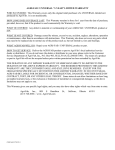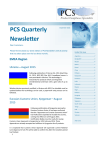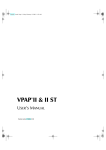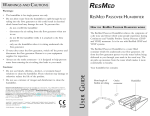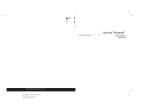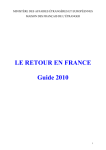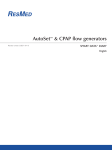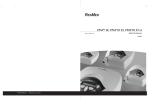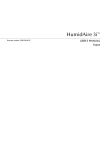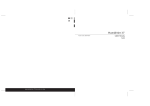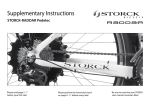Download ResMed Sullivan Comfort User's Manual
Transcript
SULLIVAN® Comfort Bi-level System Operating Manual Record of information for future reference Complete the following details when you receive your SULLIVAN® Comfort. Unit prescribed by (physician) _______________________________ Sleep clinic _______________________________ Date prescribed _______________________________ Prescribed pressures: IPAP ________________________ cm H2O EPAP ________________________ cm H2O Prescribed IPAP maximum time ________________________ seconds Delay timer maximum setting _______________________________ Mask model and size _______________________________ Flow generator serial no. _______________________________ Date of purchase _______________________________ For service, call: Equipment supplier _______________________________ Telephone no. _______________________________ In case of an emergency, call: Physician _______________________________ Telephone no. _______________________________ User/owner responsibility The user or owner of this system shall have sole responsibility and liability for any injury to persons or damage to property resulting from: • operation which is not in accordance with the operating instructions supplied; and • maintenance or modifications carried out unless in accordance with authorized instructions and by authorized persons. Please read and understand this manual before using the system. Contents 1 Introduction ...................................................................................................... 4 2 How bi-level treatment works Features of SULLIVAN® Comfort Delay timer Components of SULLIVAN® Comfort .......................................................... 3 Preparing for use ............................................................................................. 7 4 Assembling the mask system 7 Setting up the flow generator 8 Connecting the air tubing 10 Fitting the mask .............................................................................................. 11 5 Daily operation ............................................................................................... 12 6 Starting Using the START button Using the delay timer Positioning the Bubble Cushion Stopping Helpful hints ................................................................................................... 7 Use in different countries ............................................................................. 16 8 Warnings related to treatment ...................................................................... 17 9 Cleaning and maintenance ........................................................................... 18 10 Daily Weekly Periodically Replacing the air filter Servicing ......................................................................................................... 11 Troubleshooting ............................................................................................ 22 12 Accessories and spare parts ........................................................................ 24 13 System specifications ................................................................................... 26 CAUTION: 4 5 5 6 12 12 13 13 14 15 18 18 19 19 21 In the USA, Federal Law restricts this device to sale by, or on the order of, a physician. Contents 3 1 Introduction How bi-level treatment works Obstructive sleep apnea or OSA occurs when the tongue and soft palate relax during sleep, blocking the airway and cutting off the brain’s supply of oxygen. To treat OSA, nasal CPAP (Continuous Positive Airway Pressure) was developed in 1981 by Dr Colin Sullivan in Australia. In CPAP treatment, a flow generator unit provides air through a nose mask at a slightly raised pressure which keeps the airway open. The level of air pressure varies according to individual needs. Conventional CPAP treatment is carried out using a constant air pressure which can sometimes make breathing out uncomfortable. Bi-level treatment is an extension to conventional CPAP designed to overcome this. Treatment is carried out in a similar way, except that the flow generator delivers two pressures – a higher pressure when you breathe in and a lower pressure when you breathe out. Your physician will prescribe two pressures: an inspiratory or IPAP pressure for when you breath in; and an expiratory or EPAP pressure for when you breathe out. These pressures are determined during a sleep study and set by the sleep clinic staff or your equipment supplier. The SULLVAN® Comfort™ operates in a spontaneous mode, where it delivers your IPAP and EPAP pressures in response to your breathing pattern. For example, during your inspiratory breath the unit delivers your IPAP pressure; then your expiratory breath triggers the unit to switch to your EPAP pressure. This spontaneous mode of operation is aided by the set IPAP maximum time. This is the maximum length of time, within each breath period, that the flow generator will deliver your IPAP pressure before it switches to your EPAP pressure. Therefore, if your expiratory breath should fail to trigger the unit to switch to your EPAP pressure, the unit will switch automatically when your IPAP maximum time is exceeded. The IPAP maximum time is factory set. For some patients only, the physician will prescribe an individual IPAP maximum time to be set by the sleep clinic staff or equipment supplier. If you feel that you are no longer getting relief from your symptoms of sleep apnea, consult your physician immediately for advice. 4 SULLIVAN Comfort Operating Manual Features of SULLIVAN® Comfort Delay timer If you find the initial sensation of pressure uncomfortable while trying to fall asleep you may use the delay timer. This allows you to select the time it will take (5, 10 or 20 minutes) for the air pressure in your mask to build up gradually to your prescribed pressures. You will have the comfort of relatively low pressures while still awake and the assurance that the required pressures will be reached shortly after you fall asleep. See section 5, Daily operation, for instructions on use. Note: Your physician may recommend that you do not use the delay timer, or use it only to a limited degree. In this case your unit may be set accordingly. Use in different countries Your Comfort is normally used at home, but it may also be taken with you when you travel. The flow generator has a switch mode power supply which means it can operate on power supplies in other countries without any special adjustment. It can also be used in trucks and recreational vehicles. See section 7, Use in different countries. Indications for use The SULLIVAN Comfort bi-level nasal system is for the treatment of obstructive sleep apnea in adult patients. WARNING: This is not a life support device. It may stop operating with a power supply interruption or if a fault occurs in the product. If this could threaten your safety, consult your physician who can advise you about precautions that should be taken in the event of such a failure. Section 1: Introduction 5 2 Components of SULLIVAN ® Comfort You should take time to become familiar with the components of your SULLIVAN® Comfort bi-level system (see figure below). You should have: ◆ a flow generator unit; ◆ a mask frame; ◆ a length of air tubing – to connect the flow generator to the mask; ◆ adjustable headgear – to attach the mask to your head; and ◆ a nasal cushion. For details on the range of accessories available, refer to section 12, Accessories and spare parts. ResCap headgear mask frame nasal cushion flow generator air tubing SULLIVAN Comfort bi-level system 6 SULLIVAN Comfort Operating Manual 3 Preparing for use Assembling the mask system The mask frame has two access ports which should be plugged and are not used except for initial pressure setting by a technican. It has a swivelling mask elbow which allows the air tubing to be positioned without kinks. The air outlet vent allows exhaled air to escape quietly. The Modular Mask Frame (shown right) has a detachable forehead arm and T-Bar. 1 Optional T-Bar Detachable forehead arm Swivelling mask elbow Access port Air outlet vent Modular Mask Frame Before using the mask for the first time, wash the nasal cushion and air tubing in warm water using a mild detergent. Rinse thoroughly. Hang the tubing to dry. Wipe all surfaces of the mask frame with a clean, damp cloth and allow to dry. CAUTION: Do not use bleach or chlorine-based solutions to clean the cushion, mask or air tubing. These may cause hardening and reduce the life of the product. Do not hang the air tubing in direct sunlight as the tubing may crack. 2 If you are using the Modular Mask Frame, you may need to fit the forehead arm and optional T-Bar. Refer to the User Instructions supplied with the Modular Mask Frame. 3 Fit the nasal cushion to the mask frame as shown below. • Fit the cushion onto the ridge of the mask frame. The two pins on the cushion should align with the slots at the bottom of the mask frame. • Make sure the cushion is sealed all the way around. Fit nasal cushion to mask frame Section 3: Preparing for use 7 4 Fit the headgear to the mask frame as shown below. • Thread the headgear straps through the slots in the mask frame – the lower straps should also pass through the slots on the cushion. Note: If using the ResCap™, position the straps so that the sewn on “ResCap” label will be at the back of your head (lower center), facing outwards. Thread the straps in the direction of the arrows as shown. Fit headgear to mask frame Setting up the flow generator 1 Plug the power cord into the main power inlet at the rear of the flow generator. Make sure the main power switch on the unit is off (O). Insert the other end of the power cord into a power outlet. Air inlet (with filter*) Main power inlet Main power switch Power cord Plug in power cord at rear of flow generator * At the air inlet an air filter cleans the air that you breathe through the mask. The air filter strips need to be replaced periodically, see section 9, Cleaning and Maintenance, for details. 8 SULLIVAN Comfort Operating Manual 2 Switch the main switch at the rear of the flow generator on (I). Press the START button on the front panel (see figure below). Allow the unit to run for a few seconds, then press the STOP button. STOP button START button Delay timer buttons Pressure strip light display Front panel 3 4 CAUTION: Positioning the flow generator • Place the flow generator on a table close to the head of your bed. Position it carefully so that it could not be bumped from the table during the night. Make sure that you could not trip on the power cord when walking near the bed. • Make sure that the area around the unit is kept dry and clean. If dust or foreign particles are drawn into the unit it may affect treatment. • Keep the unit well clear of articles such as clothing, bedding or towels. If these obstruct the air inlet at the rear of the unit it may cause overheating and damage the unit. • Do not place the unit near a heater or a source of hot or cold air. If using a water humidifier, do not position it so that water could spill from the humidifier to the flow generator if the humidifier is bumped or overturned. Do not position a water humidifier on top of the flow generator. If water is spilt inside the flow generator, turn off the main switch at the rear and unplug the unit from the power outlet. Return the unit to your equipment supplier for checking. Section 3: Preparing for use 9 Connecting the air tubing 1 The air tubing should already be fitted at one end with the air tubing connector which inserts into the flow generator. If not, press the barbed end of the connector into the air tubing as shown below. Make sure it is firmly attached. 2 Press the air tubing connector firmly into the air outlet on the flow generator. 3 Fit the other end of the air tubing to the swivelling mask elbow of the mask frame by sliding on firmly. Note: If you are using an axial swivel connector (supplied with the Modular Mask Frame or available separately) connect this also. Refer to the User Instructions supplied with the axial swivel. Swivelling mask elbow Air outlet Air tubing connector Air tubing Connect the air tubing to the flow generator and mask IMPORTANT: 10 Make sure the power cord and plug are in good condition and the equipment is not damaged. Only use the same type of mask and air tubing as originally supplied with your flow generator. A different type of mask or tubing may alter the pressure you actually receive, thus reducing the effectiveness of your treatment. SULLIVAN Comfort Operating Manual 4 Fitting the mask The mask frame and headgear should be assembled as described in section 3, Preparing for use. To fit the mask to your face: 1 Loosen the headgear straps and pull the headgear over your head. Make sure the straps are sufficiently loose so that the nasal cushion is not pulled against your nose. 2 Position the headgear so that the bottom straps pass below your ears and the top center strap passes over the top center of your head. Check that the headgear is not twisted at the back of your head. 3 Positioning a Bubble Cushion™ If you are using a Bubble Cushion, the flow generator needs to be running to inflate the cushion before it can be securely positioned against your nose. This step is described in the following section, Daily operation. Positioning a standard cushion You do not need to inflate a standard cushion before positioning securely on your face. Simply move the mask slightly from side to side and up and down until a comfortable fit is achieved. 4 With the mask in position, lie down in your normal sleeping position. Adjust the headgear straps so that the mask sits comfortably with the forehead pads lightly touching your forehead. Do not overtighten the straps. To remove the mask Stretch the headgear slightly and pull it up and over your head. Alternatively, release one or both of the bottom straps and remove the headgear. You should not need to adjust the headgear again until it is disassembled, e.g. for weekly cleaning. Section 4: Fitting the mask 11 5 Daily operation Starting 1 Connect the air tubing to the mask and flow generator. Switch the main power switch at the rear of the unit to on (I). (See section 3, Preparing for use.) The unit will either be in standby mode (as indicated by the light above the STOP button) or it will start operating – depending on whether the unit was in standby or operating when it was last switched off at the rear. If the unit starts operating, •press the STOP button to put the unit in standby. 2 Fit the mask to your face (see section 4, Fitting the mask). 3 Settle down in bed and adjust the air tubing so it is free to move with you if you turn in your sleep. Do not leave long lengths of tubing around the top of your bed which could twist around your head or neck while sleeping. You may bring the tubing over the top of your headboard to reduce drag on the mask. Or you may prefer to run it across your shoulder. You are now ready to start the flow generator. Adjust the air tubing – try both ways and select whichever is more comfortable Using the START button Start the flow generator by pressing the START button. The pressure will rise quickly to your set pressures – the IPAP and EPAP pressures prescribed by your physician and set by the sleep clinic staff or your equipment supplier. 12 SULLIVAN Comfort Operating Manual Pressure strip light display* Delay timer buttons Front panel * The pressure strip light display gives an approximate indication of the pressure you are receiving. You will notice that the indicator lights fluctuate as the unit switches between your IPAP and EPAP pressures. Using the delay timer If you prefer to have the air pressure build up gradually while you fall asleep, select one of the delay timer buttons on the front panel (see figure above). The number on the button (5, 10 or 20) indicates how many minutes it will take for the pressure to build up from a low, barely noticeable level to your set pressures. If you want the pressure to rise very slowly, press the 20 minute button. You will soon find the rate of build-up that is most comfortable for you. The indicator lights on the strip light display will come on slowly, and reach your prescribed levels at the end of the delay period. Note: Your physician may recommend that you do not use the delay timer, or only use it to a limited degree. In this case, for example, your unit may be set to allow you to select a time delay of 5 or 10 minutes, but not 20 minutes. You may change the delay period at any time. For example, you may wish to extend the delay period if you are finding it difficult to fall asleep. Simply select one of the delay timer buttons. Or you may choose an immediate start by pressing the START button. The flow generator will always respond to the last button selected. Positioning the Bubble Cushion If you are using the Bubble Cushion, the flow generator needs to be running to inflate the cushion before it can be securely positioned against your nose. (Start the unit using either the START button or the delay timer – whichever you prefer.) Position the inflated cushion by lifting it off your face and then resting it gently against your nose. Adjust the cushion until a comfortable air seal is achieved. You may then need to readjust the headgear straps. The mask should fit just firmly enough so there are no leaks when the unit is running at your prescribed pressures. Section 5: Daily operation 13 Stopping 1 Press the STOP button to stop the flow generator. To remove the mask, stretch the headgear slightly and pull it over your head. Or release one of the bottom headgear straps. 2 When you are ready to go back to sleep, put your mask back on and restart the flow generator by pressing START or a delay timer button. Adjust the mask for comfort and to prevent air leaks. After daily use Switch off the flow generator at the main power switch at the rear of the unit. Disconnect the air tubing from the flow generator. Follow the daily cleaning instructions in section 9, Cleaning and Maintenance. As an alternative to removing your mask and headgear, you may find it easier to disconnect the air tubing from your mask as shown. When you return to bed, reconnect the air tubing to the mask and restart the flow generator. 14 SULLIVAN Comfort Operating Manual 6 Helpful hints • When you use your SULLIVAN® Comfort™ bi-level system for the first time you may notice an unusual sense of pressure when breathing. Even though a reduced pressure is delivered when you breathe out, you may still need to consciously push out when breathing out. This is normal and will occur automatically when you are asleep. At first you may feel that the pressure is impeding your breathing but this is not so. Take your time and learn to adjust to this new sensation. To help you adjust, take a few deep breaths when you start treatment. The delay timer can help overcome this problem. The pressure will build up gradually, over the period of time you select, from a barely noticeable level to your prescribed pressures. • Try to keep your mouth closed when using your Comfort. Do not try to talk. If you open your mouth, air will leak out and this may feel a little unpleasant. When you are asleep your mouth usually stays closed automatically. However, if you wake at night and open your mouth, the sensation of air rushing from your mouth might alarm you at first. You should close your mouth and try to go back to sleep. • Some people experience a continuing dryness of the nose, mouth or throat when on bi-level treatment, particularly during the winter months. ResMed produces a range of humidifiers to relieve these symptoms. Contact your physician or equipment supplier for specific advice on whether these are suitable for you. Note that your prescribed pressures may need to be reset if a humidifier is used. • Wash your face to remove excess facial oils before fitting the mask. This will help prolong the life of the cushion. • A tight fit of the mask is not necessary. The most efficient air seal is created when the mask is well-balanced and comfortable, without being pulled tight. Also, pulling the headgear straps tightly may lead to skin irritation or sensitivity of the bridge of the nose or the upper lip. It is best to set the final tension of the straps while lying down. Note: A minor leak around the lower part of the face is sometimes preferable to overtightening the mask. However, you should eliminate any air leaks blowing in the direction of the eyes as this may cause eye irritation. • If you have a continuing problem with obtaining a comfortable and secure fit with the nose mask, do not hesitate to contact your sleep clinic or equipment supplier. They may be able to modify the cushion to improve the fit, or they may suggest an alternative size or style of cushion, mask frame or headgear from the wide range now available. Section 6: Helpful hints 15 7 Use in different countries • Your SULLIVAN® Comfort™ has a switch mode power supply which means it will operate on the different power supplies in other countries. The unit accepts 110-240 V, 50-60 Hz. • No special adjustment to the unit is necessary but you should use the correct adapter for the type of power outlet in the country you are visiting. Contact your equipment supplier for information on a suitable adapter. • Always remember to pack the detachable power cord with the rest of the equipment when you travel. • Your Comfort can operate from a battery supply (e.g. in a truck or recreational vehicle), with the use of a suitable inverter unit. The inverter should be capable of supplying mains voltage in the range 110-240 V and should be of sufficient capacity. Note: A rated capacity of up to 200 W may be necessary with some brands of inverter to ensure satisfactory operation. • 16 For a list of distributors and agents worldwide, contact your equipment supplier. SULLIVAN Comfort Operating Manual 8 Warnings related to treatment The SULLIVAN® Comfort™ bi-level system is designed to help you have a good night’s sleep. However, you need to be aware of possible problems that may arise during the course of your treatment. If you have concerns about any of these problems consult your physician immediately. • You may experience sneezing, a runny nose or nasal obstruction, especially during the first few weeks of using your Comfort. This may need treatment such as a nasal spray. Consult your physician for advice. • If you experience any of the following symptoms during the course of your treatment, consult your physician immediately. - Headache - Middle ear or sinus discomfort - Chest pain - Feeling slightly bloated. This is usually the result of excessive swallowing of air in response to the pressure sensation from your Comfort while you are awake. Using the delay timer may help but contact your physician if symptoms persist. - Dryness of the nose, mouth or throat. The use of a humidifier may help. Contact your physician or equipment supplier for advice on the range of humidifiers available and whether these are suitable for you. - Air continually leaking out of the mouth while sleeping. • Do not stop your treatment without the approval of your physician. Always consult your physician if you expect to be in a situation where you cannot use your Comfort for more than a few days. • If any of the symptoms of sleep apnea recur during the course of your treatment, consult your physician. • If you are admitted to hospital or are prescribed any other form of medical treatment, always inform the medical staff that you are receiving nasal bilevel treatment. Make sure that your physician who is treating you for sleep apnea is contacted. • Skin irritation may occur from sensitivity to the material in the mask or from too much tension in the headgear straps. A correctly fitted mask and optimum tension in the straps will often prevent skin irritation. If problems persist, contact your equipment supplier or physician for advice. • If you experience an infection of the upper respiratory tract, middle ear or sinus, you should consult your physician before continuing your treatment. You may be advised to stop treatment until the infection has cleared. If you continue with treatment during an infection, it is advisable to wash your mask and tubing more often. Section 8: Warnings related to treatment 17 9 Cleaning and maintenance You should regularly carry out the cleaning and maintenance described in this section. These procedures do not require a specialist service organization. Daily 1 After daily use, wipe the inside and outside of the mask frame and nasal cushion with a clean, damp cloth. 2 Disconnect the air tubing at the flow generator and hang the tubing and mask in a clean, dry place until next use. CAUTION: Do not hang the air tubing in direct sunlight as the tubing may harden over time and eventually crack. 3 If using a humidifier, remove the short air tubing between it and the flow generator after each use. Be particularly careful to disconnect the tubing at the flow generator end first, to make sure that no water spills down the tubing and into the flow generator. 4 Clean and maintain the humidifier in accordance with the operating manual supplied with it. 1 • Remove the air tubing from the flow generator and from the mask. • Remove the headgear from the mask frame by unthreading the headgear straps. • Remove the cushion from the mask (but do not disassemble the mask frame any further). Weekly 2 Check that the air outlet vent on the mask frame is not blocked. Remove any obstruction with a pin or similar object. 3 Wash the mask frame, cushion and air tubing in warm water using a mild detergent. Rinse thoroughly (particularly the air tubing) and allow to dry. CAUTION: 4 18 Do not use bleach or chlorine-based solutions to clean the cushion, mask or air tubing. These solutions may cause hardening and reduce the life of the product. Before next use, refit the cushion to the mask frame. Refit the headgear to the mask frame. Reconnect the air tubing to the flow generator and mask. (For detailed instructions see section 3, Preparing for use.) SULLIVAN Comfort Operating Manual Periodically All items of the mask and air tubing system are subject to normal wear and tear and may eventually need to be replaced. Check periodically for excessive wear in these items. 1 When dirty, remove the headgear and wash it in warm water using a mild detergent (about every two weeks). Rinse thoroughly and drip dry. Do not use bleach. 2 Replace the forehead pads if they are dirty or worn (every three to six months). 3 Clean the exterior of the flow generator when necessary with a damp cloth, using a mild detergent. Make sure the flow generator is unplugged before cleaning, and make sure it is dry before plugging in again. Replacing the air filter 4 The air filter box at the rear of the flow generator contains two replaceable air filter strips. Check the air filter strips periodically and replace them when they become noticeably dirty (about every six months, or more often if your unit is in a dusty environment). To remove the air filter box: • • press down firmly on the center of the filter box between the two moulded arrows, Remove air filter box at rear of flow generator slide out the box. Detailed instructions supplied with the new filter strips describe how to disassemble the filter and replace the strips. CAUTION: Do not immerse the unit or power cord in water as serious damage could result. Do not use bleach, alcohol-based or chlorine-based solutions to clean the flow generator, nasal cushion, mask or air tubing. These solutions may cause hardening and reduce the life of the products. Do not wash or dry the mask frame in a temperature above 80°C (175°F). Exposure to higher temperatures may reduce the life of the product. Section 9: Cleaning and maintenance 19 20 Do not wash the filter strips as they will be damaged and will not function effectively. Do not attempt to open the flow generator unit. Repairs and internal servicing should only be performed by an authorized service agent. Do not allow water from a humidifier to spill through the air tubing into the flow generator. This may result in failure of the motor. (Damage so caused is not covered under warranty.) Do not drop or insert any objects into the air tubing or air outlet on the flow generator. SULLIVAN Comfort Operating Manual 10 Servicing Your SULLIVAN® Comfort™ is designed to give years of trouble-free operation. It is not necessary to send your unit away for regular servicing provided you follow the recommendations in section 9, Cleaning and maintenance. Should you feel that your unit is not performing properly, check section 11, Troubleshooting. If there is still a problem, contact your equipment supplier or sleep clinic. Inspection and repair should only be performed by an authorized service agent. Make sure you return your mask and air tubing with your flow generator and advise your prescribed pressures. Section 10: Servicing 21 11 Troubleshooting If you have any problems with your SULLIVAN® Comfort™, try the following suggestions. If it is still not working properly, consult your equipment supplier or take it to an authorized service agent. Do not attempt to open the flow generator. Problem Possible cause Flow generator does not start when you press START or delay timer button (and no indicator lights are showing on the front panel) Power cord not connected properly Connect power cord firmly at both ends Insufficient air delivered from flow generator Air leaking around nose and eyes 22 Solution Flow generator not switched on Switch main power switch at rear of flow generator to on (I) Power outlet may be faulty Try another power outlet Delay timer is in use Wait for air pressure to build up gradually, according to selected delay period. Or press START to override delay period. (See section 5, Daily operation.) Air filter strips are dirty Replace air filter strips (see section 9, Cleaning and maintenance) Air tubing is kinked or punctured Straighten or replace tubing Air tubing is not connected properly Tighten air tubing connections at both ends Plugs are missing from access ports Replace plugs Nasal cushion not properly fitted onto mask frame Fit cushion onto mask frame, aligning the two pins on the cushion with the slots on the mask frame (see section 3, Preparing for use) Mask and headgear straps not positioned correctly Adjust position of mask and headgear. Note that if you are using the Bubble Cushion, the flow generator needs to be running before the cushion can be properly fitted. (See section 4, Fitting the mask and section 5, Daily operation.) Plugs missing from access ports of mask frame Replace plugs Nasal cushion is torn or distorted Replace cushion SULLIVAN Comfort Operating Manual 12 Accessories and spare parts Accessories A range of accessories is available to adapt your SULLIVAN® Comfort™ to your needs. Contact your sleep clinic or equipment supplier for further information on the following items. Modular Mask Frame Kit Adapts to a wide range of face sizes and features a T-bar for added stability. The outlet vent has been designed to direct exhaled air downwards and away from partner. Comes with four sizes of forehead arm and an axial swivel connector. Triangular headgear Straps easily adjust in several directions for a comfortable fit. Available in a range of sizes. ResCap A comfortable, lightweight alternative to traditional headgear. It has been designed to provide a more secure mask attachment, resulting in fewer air leaks. The cap is made of soft, double-knit jersey fabric which allows air to circulate freely, keeping you cool. Available in a range of sizes. Bubble Cushion Series 2 and Series 3 The Bubble Cushion is renowned as one of the lightest, most comfortable cushions on the market today. Made of soft silicone rubber, the cushion conforms to the shape of your face. It adjusts itself as you move to help prevent air leaks and to eliminate the need for tight headgear. Available in a range of sizes. The series 2 is a soft membrane mounted on a thicker wall section. The series 3 is a one-piece design which makes cleaning even easier. Series 2 Series 3 Carry bag The carry bag is designed for easy carrying and protection of your Comfort bi-level system. Section 12: Accessories and spare parts 23 Humidifiers Bi-level treatment sometimes results in a dry or runny nose. ResMed produces a range of humidifiers to reduce symptoms and make treatment more comfortable. HC100 Heated Humidifier Passover Humidifier SULLIVAN® HCH Disk – a foam insert which fits inside your mask frame Air tubing Your Comfort comes with a two-meter length of air tubing which should be enough for most needs. If you find this isn’t the case, a three-meter length is available. Chin restraint The chin restraint, shown right, is designed to restrict the mouth opening during treatment and minimize air loss through the mouth. Spare parts Parts of your Comfort bi-level system will need replacing from time to time. These are available from your equipment supplier who can advise you regarding cost and delivery. 24 Access port plug Forehead pads Air filter strips Power cord (specify country of use) Air tubing – available in two or three meters Air tubing connector Axial swivel – allows air tubing to swivel at connection points SULLIVAN Comfort Operating Manual 13 System specifications SULLIVAN® Comfort bi-level system Flow generator unit PERFORMANCE Operating pressure range: 4-18 cm H2O Maximum IPAP time range: 0.2-10.8 seconds DIMENSIONS (H x W x D) 145 x 240 x 350 mm (5.7 x 9.5 x 13.8 in) WEIGHT 4.1 kg (9.1 lb) POWER SUPPLY Input range 110-240 V, 50-60 Hz, 120 VA HOUSING CONSTRUCTION Injection moulded plastic AIR FILTER STRIPS Outer filter strip – polyester fibre Inner filter strip – open cell polyester-urethane foam Air tubing Flexible plastic, 2 m (6 ft 6 in) length IEC 601-1 Classifications Class II, Type CF Note: The manufacturer reserves the right to change these specifications without notice. Glossary Read Operating Manual before using/Lire le manuel d'utilisation avant emploi Class II (double insulated)/Classe II (double isolation) Type CF equipment/Appareil de classe CF Section 13: System specifications 25 • ResMed Corp 14040 Danielson Street Poway CA 92064-6857 USA Tel: +1 (858) 746 2400 or 1 (800) 424 0737 Fax: +1 (858) 746 2900 Email: [email protected] • ResMed GmbH & Co KG Rudolfstraße 10 D-41068 Mönchengladbach Germany Tel: +49 (0 2161) 3521-0 Fax: +49 (0 2161) 3521-299 Email: [email protected] • ResMed Malaysia Sdn Bhd Unit 4.04, Wisma BICMA Jalan 243/51A 46100 Petaling Jaya Selangor Malaysia Tel: +60 3 7877 9099 Fax: +60 3 7877 6099 Email: [email protected] • ResMed Ltd 97 Waterloo Road North Ryde 2113 Australia Tel: +61 (2) 9886 5000 or 1 800 658 189 Fax: +61 (2) 9889 1483 Email: [email protected] • ResMed SA Parc de la Bandonnière 2, rue Maurice Audibert F-69800 Saint Priest France Tel: +33 (04) 3725 1251 Fax: +33 (04) 3725 1260 Email: [email protected] • ResMed NZ Ltd PO Box 51-048 Pakuranga Auckland New Zealand Tel: +64 9530 9049 or +0800 737 633 (NZ toll free) Fax: +64 95309048 Email: [email protected] • ResMed (UK) Limited 67B Milton Park Abingdon Oxon OX14 4RX UK Tel: +44 (1235) 862 997 Fax: +44 (1235) 831 336 Email:[email protected] • ResMed Singapore Pte Ltd 150 Kampong Ampat #06-06 KA Centre Singapore 368324 Tel: +65 284 7177 Fax: +65 284 7787 Email: [email protected] • ResMed Sweden AB Industrigatan 2 S-461 37 Tollhättan Sweden Tel: +46 520 420 110 Fax: +46 520 397 15 Email: [email protected] Protected by: AU 699726, AU 713679, EP 0088761 (DE,FR,GB), JP 1697822, US 4944310, US 5199424, US 5522382 Other patents pending SULLIVAN, Bubble Cushion and ResCap are trademark of ResMed Ltd. © 2000 ResMed Ltd. 21802/3 00 08


























